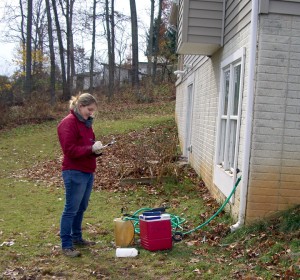MGS Report Reveals Majority of Harford County Well Water at Safe Lead Levels
November 18, 2013 - (reprinted from AccessDNR press release)

The Maryland Geological Survey (MGS), in cooperation with the Harford County Health Department, has published a report evaluating lead concentrations of well water in the Piedmont part of Harford County ─ the area north and west of Interstate 95. Conducted in response to concerns over the possibility of lead in well water in the area, the study indicates that the majority of homes tested were at safe levels.
Evaluation of Lead Concentrations in Well Water from the Piedmont Area of Harford County, Maryland, by Katherine Burgy of MGS, and John Resline and Peter Smith with the Harford County Health Department, presents the results of lead, pH and other water-quality tests in samples collected in the study area.
“This report improves our understanding of regional groundwater quality and provides critical information needed to make wise water-management decisions,” said David Bolton, hydrogeology and hydrology program chief, MGS.
Three water samples at different points in the distribution system were tested for lead in the 80 homes within the study area. Water distribution system refers to those parts of any system that transports water from a source ─ in this case groundwater ─ to the consumer and can include plumbing fixtures, adapters, pipe fittings and other parts. As water passes through the distribution system, its quality can be affected by chemical reactions and biological processes that can cause the release of metals into the water with undesirable aesthetic and health effects.
Findings indicate that 93 percent of homes tested came in at safe levels, defined by the EPA as less than or equal to 15 micrograms of lead per liter of water. The tests also found that in the remaining 7 percent of households, the higher levels were associated with water distribution systems and not geological sources.
Harford County Health Officer Susan Kelly recommends using only the cold water tap for drinking and cooking purposes, and flushing the tap for 30 seconds or until the water temperature changes prior to use, especially if it has not been used for more than 6 hours. If the tap is in relatively constant use during the day, a shorter flush time may suffice. Water flushed from the tap can be used to water plants, wash dishes or clothing, or clean. Because human skin does not absorb lead from water, bathing and showering are safe for adults and children.
Once wells are placed into service, they become the responsibility of homeowners. Residents of homes with wells are reminded to have water periodically sampled and tested for lead and any other potential contaminants. Test results should guide decisions about whether water treatment systems are necessary.
Both Bolton and Kelly agree that a sustainable supply of clean drinking water is crucial to the health and wellbeing of the citizens of Maryland, and to a strong economic future for the State. Aside from being a critical drinking water source, groundwater is also important for agricultural, commercial and industrial uses. Because groundwater supplies water to streams and rivers, it is also vitally important for sustaining healthy populations of fish and other aquatic organisms.
For more information on this study, contact Bolton at [email protected] or the Harford County Health Department at 410-612-1771.
More Information
 Report of Investigations 81
Report of Investigations 81To learn more about the health effects of lead, visit https://www.epa.gov/lead


